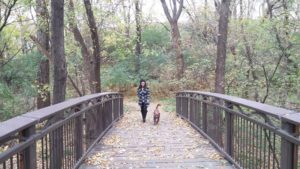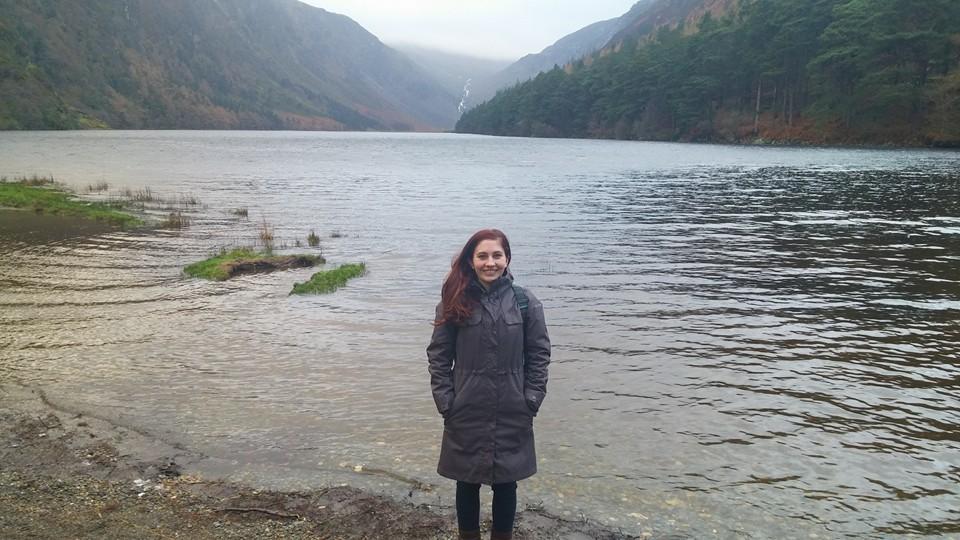Guest post by Caroline P. James
 One of my favorite things to do in Minneapolis, MN is take my dog for a walk during the fall. The weather is refreshing, and nature is full of surprises and beauty. My dog, as many of other dog moms and dads out there can relate to, also goes NUTS for the new smells and falling leaves.
One of my favorite things to do in Minneapolis, MN is take my dog for a walk during the fall. The weather is refreshing, and nature is full of surprises and beauty. My dog, as many of other dog moms and dads out there can relate to, also goes NUTS for the new smells and falling leaves.
When we first adopted Islay into our family, my husband and I were taking a class together on mindfulness. As our instructor told us, “being with your puppy is being present.” On our daily walks through the woods near my house, I smile to myself over her intense need to experience the present and engage with now.
Islay has not only taught me a lot about being present in the moment, but also about being actively engaged in the present. I couldn’t help but recollect my experience as a program leader for study abroad courses with a local Twin Cities University. One of our biggest challenges as leaders was to facilitate and encourage engagement. As many international educators know, disengagement is a common challenge with any study abroad or experiential learning opportunity. The culture shock can often trigger ‘fight or flight’ responses, and with global accessibility to family and friends through social media and email, it can be very easy to check out of what’s happening in the present.
This is the area in which my dog has taught me some lessons, or rather, what I have learned while walking her, as it pertains to student engagement while abroad.
1. Engagement can be intense
Islay has been known to pull people to the ground while on a leash. She is VERY sure about what she wants, and has some very strong muscles to get her there. Whenever we get out for a walk, she’s pushing her nose into the leaves, grass, dirt (the list goes on), and truly taking in everything as if this were her last walk ever. I believe the beauty in her engaging with her surroundings on every level is very translatable for what we can teach our students while abroad.
As an international program leader, I’ve taken students to areas with recent histories of conflict and turmoil. During one of our programs in Northern Ireland, I incorporated meditative processing techniques to assist our students in engaging with the events of Bloody Sunday (1972). We had just walked through the physical locations where British soldiers shot 26 unarmed civilians during a protest march. Our guide was Jon McCourt ,former IRA member and now peace activist. Jon was involved in the civil rights march during Bloody Sunday and has vivid memories running away from the gunshots being fired at him and other civilians. At one point during our walk, he pointed our group to the place he stood where he faced a British soldier who, for whatever reason, decided Jon’s life was not worth ending that day.

I realized in that moment that my students’ need for quiet, rather than a group discussion, I developed a meditative activity taking the students through the events of the day, prompting them to engage all five senses in remembering – sights, smells, sounds, even referring to how cold it had been that day. In this activity, I asked the students to be still and revisit these moments as if they were still visiting the site of Bloody Sunday. I incorporated some of the themes of our course – justice, conflict, human rights, and reconciliation. Afterwards, having had the balance of internal and external thought, the students were able to articulate their experiences in such a way that was critical, yet respectful of what they had encountered that day. They could soak in and engage with a difficult topic without having to instantly produce a half-hearted response just for the sake of ‘participation points.’
2. Heads Up!
As a program leader during a study abroad course, it’s easy to get caught up in balancing all the hats expected of you – counselor, advisor, travel agent, budget gatekeeper, and educator. As a program leader, I would often find myself lost in the details, and spent less time engaging with my surroundings myself, despite encouraging (and expecting) my students to do this! My free time would largely be spent going over budgets or grading journal entries, to the extent that I had little energy or interest at times to enjoy the experience myself.
Some research on dog/human relationships will tell you that it is important when walking your dog to not always look down at them. This research shows that when walking your dog, it’s important to look up and look forward (and not always at your dog!), so they see you as their alpha and take your lead on where to go. I catch myself looking at Islay all the time because, well, she’s my four-legged baby! I love seeing her explore and experience everyday things I take for granted with such intensity and wonder (not to mention, I just think she’s awesome!). In a similar way, I love watching my students engage in new ideas and cultures, and hearing how they mentally and spiritually work out course themes. Can you guess the connection here? It’s important for us as educators to delve as deeply into the culture as our students do. Students will follow your lead. If they see your active interest and engagement (and enjoyment in doing so!), they’ll see their time abroad as less of a simple tourist excursion, and more of a holistic and personally meaningful cultural exploration.
This is likely stating the obvious, but it’s important to emphasize that taking the time to really engage with the culture and location while you’re there is for you as well! It’s an amazing opportunity to explore the world, and we don’t always get the opportunity to do so! In the past, I’ve mapped out a few things I would like to go do or see (live music at a pub, local restaurant, nearby hike), and have invited students to join me. What is helpful about this is essentially scheduling these fun activities, so that the times I didn’t have anything on my ‘schedule,’ I could focus on the details of the program.
3. Leave your mark, and revisit!

This is a lesson for us as well as students. Dogs stay in touch with places they have visited in the past. There is a term common among dog lovers called “pee mail,” meaning dog’s leaving their mark, and often “checking” it on future walks. It’s imperative to encourage our students (and to remind ourselves) not just to leave our time abroad at the airport. We need to give students tools for re-entry and continuing their lessons learned to apply into their context at home. This is one of the most important lessons in active engagement – application! Coming back home after time learning abroad is a shock and, without proper tools to move forward,
During my course in Cambodia, I had our students make note cards answering questions such as, ‘How will you tell your friends about this course in 3 sentences?’ and ‘What resources can you utilize to help you stay informed on human trafficking?’ and ‘What, if anything, do you want to do to stay involved? ’ Throughout the entirety of our course in Northern Ireland, we paralleled the sectarian conflict to ongoing issues of race happening back in the US. This allowed our students to not just see this as a problem in some other country, but something they could relate to, and even see through a different lens. There was even an interesting perspective of hope gained when our students not only learned about conflict, but also reconciliation, and how to apply theories and actions back in their home context.
I also introduced my class to coloring as a processing technique to help understand their unfiltered thoughts and emotions behind the topics covered over the course of the program. This was also towards the end of our trip, where the class had begun to brainstorm their final projects. I asked them to consider using two colors – one for peace, and one for conflict. With these two colors, I prompted them to evaluate their understanding of the intersections of peace and conflict and to analyze the several dimensions attached to each. We then processed in a group setting what they experienced while doing the activity, and what it means for their understanding of the topic in the Northern Ireland context, and also for their own context back in the United States. Coloring engages the brain areas related to motor skills – the senses and creativity. So this activity was an easy, affordable, and innovative way to allow my students to apply their authentic engagement with course material into their final project.
While it may not be an option for our students to revisit the physical location visited while studying abroad (like our dogs do on their daily walks), providing these tools for students to continually engage with content learned is key for the learning process. As educators, this is also key for our ongoing commitment to transformative learning through active and ongoing engagement.
In creating this alternative avenue for learning, I allowed for multiple learning styles to be honored as well as authentic processing and engagement to take place. The students were literally guided through a meditation of sorts and encouraged to use all five senses to remember what they encountered. This deeply immersive strategy can ground us and allow us to feel more comfortable with engaging in the present moment.
 About the Author: Caroline has attempted to center her life around being comfortable with the uncomfortable – whether that means teaching, studying, or living abroad; studying the intersections of gender and power; denouncing her Chicago-born status and moving to Minneapolis; or fiercely loving a wonderfully timid dog. You can reach her via LinkedIn or over at Twitter.
About the Author: Caroline has attempted to center her life around being comfortable with the uncomfortable – whether that means teaching, studying, or living abroad; studying the intersections of gender and power; denouncing her Chicago-born status and moving to Minneapolis; or fiercely loving a wonderfully timid dog. You can reach her via LinkedIn or over at Twitter.
